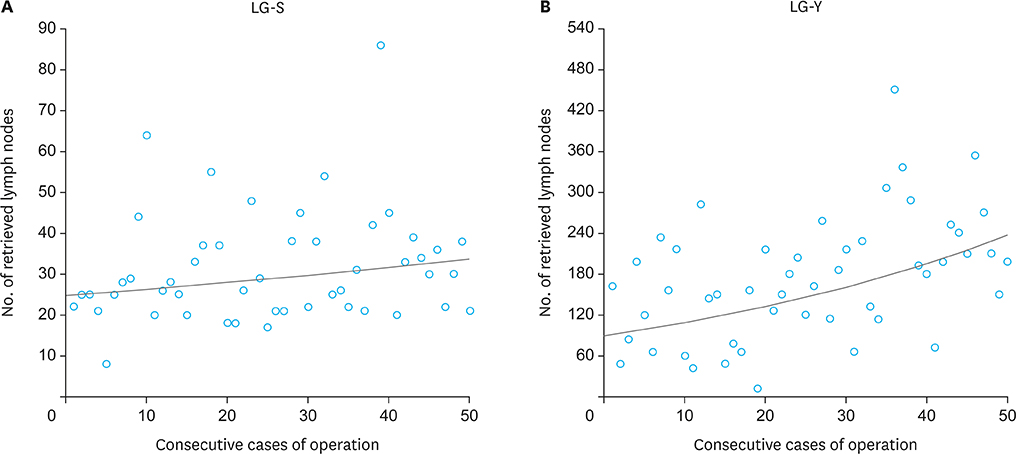J Gastric Cancer.
2017 Sep;17(3):237-245. 10.5230/jgc.2017.17.e30.
Laparoscopic Gastrectomy Performed by an Expert in Open Gastrectomy
- Affiliations
-
- 1Department of Surgery, Chung-Ang University College of Medicine, Seoul, Korea. jmpark@cau.ac.kr
- KMID: 2389828
- DOI: http://doi.org/10.5230/jgc.2017.17.e30
Abstract
- PURPOSE
Senior surgeons prefer open gastrectomy (OG), while young surgeons prefer laparoscopic gastrectomy (LG). The purpose of this study was to evaluate the surgical outcomes of LG performed by a senior surgeon who was an expert in OG during his learning period, by comparing them with LGs performed by a young surgeon.
MATERIALS AND METHODS
A senior surgeon performed 50 curative gastrectomies with laparoscopy (LG-S group) from March 2015 to August 2016. A young surgeon's initial 50 LGs comprised the LG-Y group. Clinicopathological characteristics and surgical outcomes were compared between the LG-S and LG-Y groups.
RESULTS
D2 lymphadenectomy was more frequently performed in the LG-S group than in the LG-Y group (P=0.029). The operation time and number of retrieved lymph nodes did not significantly differ between the 2 surgeons (P=0.258 and P=0.410, respectively). Postoperative hospital stay and postoperative complication rate were similar between 2 groups (P=0.234 and P=1.000, respectively). Similarly, significant decreases in operation time with increasing case numbers were observed for both surgeons, whereas the number of retrieved lymph nodes increased significantly in the LG-Y group but not in the LG-S group.
CONCLUSIONS
The LG outcomes when performed by the senior surgeon were comparable to those when performed by the young surgeon, despite performing more extended lymphadenectomies. Senior surgeons who are experts in OG should not refrain from performing LG.
Keyword
MeSH Terms
Figure
Reference
-
1. Kim YW, Baik YH, Yun YH, Nam BH, Kim DH, Choi IJ, et al. Improved quality of life outcomes after laparoscopy-assisted distal gastrectomy for early gastric cancer: results of a prospective randomized clinical trial. Ann Surg. 2008; 248:721–727.2. Kim HH, Hyung WJ, Cho GS, Kim MC, Han SU, Kim W, et al. Morbidity and mortality of laparoscopic gastrectomy versus open gastrectomy for gastric cancer: an interim report--a phase III multicenter, prospective, randomized trial (KLASS Trial). Ann Surg. 2010; 251:417–420.3. Kitano S, Shiraishi N, Fujii K, Yasuda K, Inomata M, Adachi Y. A randomized controlled trial comparing open vs laparoscopy-assisted distal gastrectomy for the treatment of early gastric cancer: an interim report. Surgery. 2002; 131:S306–S311.4. Kodera Y, Fujiwara M, Ohashi N, Nakayama G, Koike M, Morita S, et al. Laparoscopic surgery for gastric cancer: a collective review with meta-analysis of randomized trials. J Am Coll Surg. 2010; 211:677–686.5. Kim HH, Han SU, Kim MC, Hyung WJ, Kim W, Lee HJ, et al. Long-term results of laparoscopic gastrectomy for gastric cancer: a large-scale case-control and case-matched Korean multicenter study. J Clin Oncol. 2014; 32:627–633.6. Kunisaki C, Makino H, Yamamoto N, Sato T, Oshima T, Nagano Y, et al. Learning curve for laparoscopy-assisted distal gastrectomy with regional lymph node dissection for early gastric cancer. Surg Laparosc Endosc Percutan Tech. 2008; 18:236–241.7. Moon JS, Park MS, Kim JH, Jang YJ, Park SS, Mok YJ, et al. Lessons learned from a comparative analysis of surgical outcomes of and learning curves for laparoscopy-assisted distal gastrectomy. J Gastric Cancer. 2015; 15:29–38.8. Park YK, Yoon HM, Kim YW, Park JY, Ryu KW, Lee YJ, et al. Laparoscopy-assisted versus open D2 distal gastrectomy for advanced gastric cancer: results from a randomized phase II multicenter clinical trial (COACT 1001). Ann Surg. Forthcoming. 2017.9. Hur H, Lee HY, Lee HJ, Kim MC, Hyung WJ, Park YK, et al. Efficacy of laparoscopic subtotal gastrectomy with D2 lymphadenectomy for locally advanced gastric cancer: the protocol of the KLASS-02 multicenter randomized controlled clinical trial. BMC Cancer. 2015; 15:355.10. Hirahara N, Matsubara T, Hyakudomi R, Hari Y, Fujii Y, Tajima Y. Laparoscopic stomach-partitioning gastrojejunostomy with reduced-port techniques for unresectable distal gastric cancer. J Laparoendosc Adv Surg Tech A. 2014; 24:177–182.11. Kang SY, Lee SY, Kim CY, Yang DH. Comparison of learning curves and clinical outcomes between laparoscopy-assisted distal gastrectomy and open distal gastrectomy. J Gastric Cancer. 2010; 10:247–253.12. Jin SH, Kim DY, Kim H, Jeong IH, Kim MW, Cho YK, et al. Multidimensional learning curve in laparoscopy-assisted gastrectomy for early gastric cancer. Surg Endosc. 2007; 21:28–33.13. Yoo CH, Kim HO, Hwang SI, Son BH, Shin JH, Kim H. Short-term outcomes of laparoscopic-assisted distal gastrectomy for gastric cancer during a surgeon's learning curve period. Surg Endosc. 2009; 23:2250–2257.
- Full Text Links
- Actions
-
Cited
- CITED
-
- Close
- Share
- Similar articles
-
- Laparoscopic Billroth-II Gastrectomy for Benign Gastric Disease
- Current status of robotic gastrectomy for gastric cancer: A review of recent randomized controlled trials
- Improved Surgical Outcomes of Laparoscopic Gastrectomy Compared with Conventional Open Gastrectomy for Gastric Adenocarcinoma in Obese Patients
- Laparoscopic Distal Gastrectomy for Gastric Cancer
- Current Issues in Reduced-Port Gastrectomy: A Comprehensive Review



